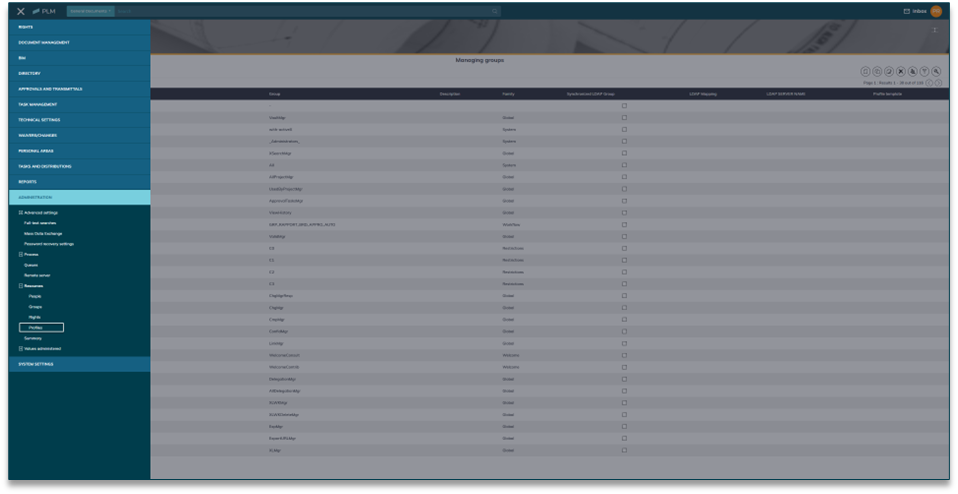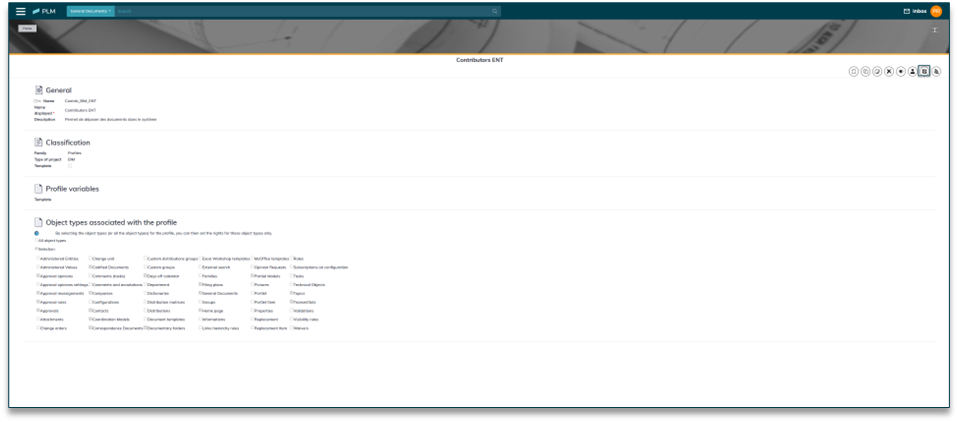General rights
Overview
General rights are implemented as user groups that control access to specific functional areas of the application. These rights determine whether users can perform key actions such as formulating data, importing files, or configuring home pages.
Assignment and Configuration
These rights are not universally granted to all users. Instead, they are assigned selectively to certain individuals or to members of specific user groups. This allows for a tailored permission model that aligns with each user's role and responsibilities within the organization.
Configuration of these rights is managed through Profiles, where administrators can parameterize which, general rights are associated with which roles. This profile-based assignment model enhances flexibility and simplifies management by allowing bulk configuration based on user roles.
Simplifying Administration
To streamline the administrator’s daily tasks, general rights, previously referred to as responsibilities have been consolidated into a category called General within the group settings. This integration helps centralize and organize access control, making it easier to locate and manage the relevant rights.
Most of these general rights are pre-assigned to the Administrator group, ensuring that users in this role have full access to manage the application and oversee its configuration and operation.
Rights Enforcement
It is important to note that even if a user interface element (such as a button or menu option) appears visible to a user, the system will still perform a rights check before allowing the action to proceed. This safeguard ensures that only authorized users can execute restricted operations, even if the functionality is visually accessible.
By grouping and parameterizing general rights, PLM provides a structured and secure way to manage application functionality while maintaining administrative efficiency and enforcing appropriate access control throughout the system.
Modify general rights in a profile
Go to the Profiles Section
-
Click on the Burger menu in the top-left corner.
-
Go to Administration.
-
Select Resources.
-
Click on Profiles.

-
You will now see the Profiles page with a list of existing profiles.

-
Select a Profile. Click on the name of the profile you wish to view or manage. This will open the profile details page.

-
Profile page list. On the profile page, click Manage General Rights.

-
Configure general rights. A tabbed interface will open, displaying general rights grouped by categories. Each tab contains a list of specific rights that can be modified.

-
To configure access rights for a particular object type, you can toggle the rights by clicking on the corresponding icon:
|
Current Status |
Action |
Result |
|---|---|---|
|
|
|
Changes to Enabled (Green icon) |
|
|
|
|
This allows you to quickly grant or revoke access rights for each general right linked to the profile.
Example of a General Right: ImpMgr
The ImpMgr right is a general access right used to control access to the data import feature within the PLM application.
Purpose
-
This right ensures that only authorized users can perform data imports, which is a sensitive and potentially high-impact operation.
Behaviour
-
Users who have the ImpMgr right will be able to see and use the import button in the interface.
-
Users without this right will not see the import button at all, effectively preventing them from accessing the feature.
This is a practical example of how general rights can be used to control access to specific application functions, enhancing both usability and security.
Default General Rights in PLM
The following is a list of general rights that are available by default in PLM. These rights can be extended or customized based on customer-specific requirements.
Each right (also referred to as “responsibility") grants users’ access to administrative or functional capabilities within the application.
| Responsibility | Access Description |
|---|---|
|
Admin |
Allows creation of dictionaries and configuration of technical elements; enables setup of system settings and user profiles. |
|
AllDelegationMgr |
Grants the ability to create delegations for any user in the system. |
|
AllProjectMgr |
Allows users to browse across PLM without being tied to a specific project; users can view all projects and associated objects. |
|
ChgMgr |
Full management of change orders, including creation, modification, and deletion. |
|
ChgMgrResp |
Administration of change folders within change order management. |
|
CmpMgr |
Permission to make comparison statuses public. |
|
ConfidMgr |
Enables the modification of confidentiality settings. |
|
DelegationMgr |
Allows users to create a delegation for their own account. |
|
ExpMgr |
Grants the ability to perform data exports. |
|
ExportURLMgr |
Right to create URL links to access vault objects. |
|
FltMgr |
Allows the creation of public filters. |
|
FlatMgr |
Enables creation of public templates for flattened configurations. |
|
HistoMgr |
Grants the skill to make a file invisible by changing its status to Historized (used to avoid displaying the latest validated version). |
|
ImpMgr |
Enables data import functionality. |
|
LinkMgr |
Grants rights to administer link hierarchy rules. |
|
MClassMgr |
Provides access to multi-type search capabilities. |
|
MilMgr |
Rights to create, modify, and delete processes (workflows or milestones). |
|
NoProjectMgr |
Allows a user to log in using “no project” mode, even without being assigned to any authorized project. |
|
ObjectsSubscriptionsMgr |
Enables users to subscribe to a group to a filter. |
|
ProjectMgr |
Allows a user to modify project data even if they are not a member of the project group. |
|
SettingsMgr |
Right to manage user-specific settings. |
|
SmartViewMgr |
Grants permission to make Smart Views public for shared usage. |
|
StateMgr |
Allows manual status modification of items. (Note: statuses like “In modification” or “In work” cannot be manually modified.) |
|
TaskMgr |
Enables users to manage tasks. |
|
UsedByProjectMgr |
Allows modification of nodes without filtering based on the current project. |
|
ValidMgr |
Permission to change an item’s status to "Valid". |
|
VaultMgr |
Grants access to vault classification features. |
|
WelcomeMgr |
Right to configure welcome pages shown upon login. |
General Description of Rights by Category
The following tables list and describe the default general rights (also referred to as responsibilities) in PLM. These rights are categorized based on their functional area. Each right grants access to specific features or behaviours within the application.
-
Organization per Project
|
Right |
Description |
|---|---|
|
AllProjectMgr |
Allow navigation throughout the application without being tied to the current project. The user can view all projects and associated objects. |
|
NoProjectMgr |
Allow users without access to any project to log in using the "No Project" mode. |
|
ProjectMgr |
Grants permission to modify a project even if the user is not part of a project-specific group. |
|
UsedByProjectMgr |
When inserting or replacing a node in a project template configuration, this right disables the "Initialize the filter with the current project" constraint. |
-
Data Export
|
Right |
Description |
|---|---|
|
ExpMgr |
Grants the ability to export data from a personal location. |
|
ExportURLMgr |
Allows users to create URL links to repository objects (specific to Lascom AEC). |
|
XLMgr |
Enables visibility of the “Export to Excel” button. |
|
XLWKDeleteMgr |
Grants access to the "Include deleted lines" checkbox when importing Excel files (OfficeWorkshop module). |
|
XLWKMgr |
Enables the "Export to Excel with Template" button in OfficeWorkshop. |
-
Publishing
|
Right |
Description |
|---|---|
|
CmpMgr |
Allows publishing of comparative models. |
|
FlatMgr |
Grants the ability to publish pooled configuration templates. |
|
FltMgr |
Enables publishing of filters (typically assigned to FltMgr group). |
|
MClassMgr |
Grants the ability to publish multi-type searches. |
|
SmartViewMgr |
Allows making a hierarchical search public. |
|
XSearchMgr |
Enables users to make advanced (deep) searches public. |
-
Advanced Profile Management
|
Right |
Description |
|---|---|
|
AllDelegationMgr |
Grants permission to create delegations for any user. |
|
ChgMgr |
Allows management of change orders (create, delete, modify). |
|
ChgMgrResp |
Grants administrative rights over change folders. |
|
DelegationMgr |
Allows users to create delegations for their own accounts. |
|
HistoMgr |
Adds the ability to set a form to “Historic” state, hiding it from recent views. Without this right, historic forms may reappear as the last valid version. |
|
ImpMgr |
Enables data import functionality. |
|
MilMgr |
Allows access to broadcast processes and related file repositories. |
|
SettingsMgr |
Grants access to manage user options and preferences. |
|
VaultMgr |
Required to view and manage vault classifications. |
|
TaskMgr |
Enables full task management (tasks, groups, and models). |
|
ValidMgr |
Grants permission to validate documents, including high-priority validation at creation time. (Note: requires preconfigured validation workflows.) |
|
WelcomeMgr |
Allows creation or modification of welcome (home) pages for all users. |
-
Special Profiles
|
Right |
Description |
|---|---|
|
Admin |
Enables dictionary creation, system parameter configuration, and user profile definition. Also includes the ability to regenerate history. |
|
ConfidMgr |
Grants the ability to modify the internal CONFID property (confidentiality field), provided the dictionary mask hasn’t been intentionally overridden. |
|
LinkMgr |
Right to manage objects in the link hierarchy module; integrates with the System Administrator plug-in. |
|
MilMgr |
Enables users to view the broadcast structure tree. |
|
ObjectsSubscriptionsMgr |
Allow users to subscribe to a group to a filter. |
|
StateMgr |
Grants manual modification rights over the STATE property (status). Note: “In Modification” and “In Work” statuses cannot be changed manually unless dictionary settings allow it. |
 Right Disabled (Red icon)
Right Disabled (Red icon)